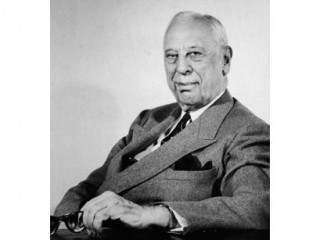
Alfred P. Sloan biography
Date of birth : 1875-05-23
Date of death : 1966-02-17
Birthplace : New Haven, Connecticut
Nationality : American
Category : Arhitecture and Engineering
Last modified : 2010-11-21
Credited as : Electrical engineer, automobile executive, president and chairman of General Motors
The American automobile executive Alfred Pritchard Sloan, Jr./ (1875-1966), pioneered in automotive innovation and built General Motors into one of the world's largest companies.
Alfred P. Sloan, Jr., was born on May 23, 1875, in New Haven, Conn., the son of a prosperous businessman. In New York City he attended the Brooklyn public schools and the Polytechnic Institute, where he passed the exams to enter the Massachusetts Institute of Technology, but he was refused admission because he was too young. At the age of 17 he did matriculate there and received a bachelor's degree in electrical engineering in 1895.
Sloan obtained a position as draftsman in the Hyatt Rolling Bearing Company at Harrison, N.J. By this time he had married Irene Jackson of Boston. At the age of 26 he became president and general manager of the rapidly failing firm when his father and one other man bought control. Sloan quickly resuscitated the firm by moving into the manufacture of steel roller bearings for the mushrooming automobile industry.
While Olds Motor Company was Sloan's first customer, Ford Motor Company became the largest. Hyatt profits ran as high as $4 million annually, but Sloan grew concerned with rumors that General Motors (GM) might produce its own bearings. Instead, William C. Durant, the energetic builder of GM, bought Sloan's firm for $13,500,000 and merged it as part of the United Motors Corporation, with Sloan as president. In 1918 he became a vice president and member of the GM executive committee.
Durant lost control of GM in 1920 to the Du Ponts, but Pierre Samuel du Pont, the new president, knew nothing about automobiles and made Sloan vice president in charge of operations. Three years later Sloan became president of GM and a director of the Du Pont Company. In 1920 GM held a 12 percent share of the market; by 1956, when Sloan retired, the market share stood at 52 percent. He accomplished this not only by innovations such as four-wheel drive, crankcase ventilation, and knee-action brakes but, more importantly, by adopting the staff principle of management. He centralized administration and decentralized production and put each product in its own division and eliminated intracompany competition.
Sloan made a great philanthropic contribution in 1937, when he endowed the Alfred P. Sloan Foundation with $10 million; to 1966, his gifts totaled over $305 million. Major recipients were the Sloan-Kettering Institute for Cancer Research and the Massachusetts Institute of Technology. He died Feb. 17, 1966, in New York City.
The only full-length works on Sloan are autobiographical. An early account of himself, written with Boyden Sparkes, is Adventures of a White-collar Man (1941). Sloan's My Years with General Motors (1963) is an illuminating book on business history and his role in it. Paul Franklin Douglass, Six upon the World: Toward an American Culture for an Industrial Age (1954), includes an essay on Sloan and his significance.
Sloan, Alfred P. (Alfred Pritchard), My years with General Motors, New York: Doubleday/Currency, 1990, 1963.
Weaver, Warren, Alfred P. Sloan, Jr., philanthropist, New York:Alfred P. Sloan Foundation, 1975.
















